About the Microfauna - The Plankton’s Story
One of the principal investigators (PI’s), Dr. Rudi Scheltema, has made
the following contribution to the Journal. In this he shares with you how
his part of the grant partnership (shared with Dr. Ken Halanych, Chief
Scientist) works in the Cruise Plan. We log the raw field data, and from
that Dr. Scheltema will write a report to the National Science Foundation
and likely publish a journal paper at a later date. I will quote (and
paraphrase) here the text Rudi contributed on the last cruise, in November
2004, that will further explain to you new readers the purpose of this
cruise and associated study. In a later Journal, he will provide an
account on what they’ve learned so far, from the first 2 cruises to Antarctica.
“The Drake Passage is the seaway separating the South American and the
Antarctic continents. We make collections of drifting planktonic
[“wandering”] organisms by putting collecting nets over the side of the
ship every few hours [weather permitting] along a route between Staten
Island (off Argentina) and the South Shetland Islands (off Antarctica)
using a fine-meshed net three-quarters of a meter in diameter at its mouth
(ca. 39?). Why do we wish to undertake such a strenuous program?
About 100 million years ago, during the Jurassic and Cretaceous
geologic time periods, the single existing super continent named Pangaea
became divided into two parts. One, Laurentia, “drifted” by means of plate
tectonics to the north forming the continents of the northern hemisphere;
the other half, Gondwanaland, moved to the south to form the continents of
the southern hemisphere, namely, Africa, Australia, South America and the
Antarctic. Then more recently, about 40 million years ago, Antarctica and
South America separated to form the Drake Passage which we now cross on our
way to the Antarctic continent.
As a consequence of this separation, the marine organisms that live in
the waters surrounding the Antarctic continent (in particular the Antarctic
Peninsula and South Shetland Islands) have been long isolated from South
America. So long, in fact, that they have changed significantly and
evolved into a new unique “local” fauna, different but related most
recently (remember, in geologic time) to that of South America. While the
majority of marine bottom dwelling organisms differ from those of South
America, some groups (taxa) remain largely unchanged and are found on both
the South American and Antarctica continents, including 40 to 50 percent of
all mud-dwelling worms and about a third of all echinoderms (meaning “spiny
skinned”), which include sea stars and brittle stars. If such species are
to remain unchanged they must have had some means to maintain contact with
one other, that is, to reproduce with one another. We suggest that this
contact may be maintained through the dispersal of their minute larvae
passively carried long distances by ocean currents (i.e., they didn’t set
out to “swim” there). Such dispersal is similar to that of plant seeds,
for example milkweed seeds which may be carried by the wind or “air currents”.
So we will undertake to discover if larvae might not be carried long
distances maintaining genetic continuity or reproductive relationship, like
those we have established for tropical oceanic waters. We shall attempt to
discover larvae in the Drake Passage and to determine how the “water
babies” contribute to the geographic distribution of marine invertebrate
bottom-dwelling organisms.”
That is the purpose of a large part of the ‘Plankton Team’s’ role of this
research study to capture and identify many of the floating spawn among
the ocean’s population. The other part that complements this is the“Benthic Team” side. Each time we do a benthic or “bottom” dredge, a large
metal frame with a net attached is dropped to the ocean bottom, and is
dragged for several minutes, collecting bottom-dwelling creatures. By
comparing the DNA of the plankton and the ‘adult’ animals, these great
minds will put together conclusive data documenting and pairing larvae with
adult.
Every good specimen that is identified by eye as well as under a microscope
is photographed and catalogued. Some of the critters are known in their
taxonomic pairing (though not by DNA yet), and others are known by their
families, but not for sure by their larval-to-adult relationships. Check
out the images at right:
So here’s the point of this study these samples will all be analyzed via
DNA technology, and their ‘relatives’ will be much more easily identified,
if not definitively so.
Catch of the Day Finback whales
Perks of the trade a herd of finback (or are they humpback? The debate
continues…) whales joined us today during the plankton tow portion of our
program. About 10 whales visited I mean, they swam along side, tipped on
their sides to look at us watching them, and even swam under the ship while
we moved very slowly in the water. Andy Mahon contributed one view of
these magnificent visitors or are they the hosts and we the visitors? in
these Southern Ocean waters.
Don't hesitate to email
questions to us at outreach@lmg.usap.gov
|
|
Longitude/Latitude:
S63° 30.055’ W61° 31.914’
Temperature:
Wind: N 25kn
Air Temp: 1.9°C Wind Chill: -16.2°C Water Temp: -0.333°C
Menu:
Baked ham, roast turkey, peas, carrots, green beans, cinnamon
rolls, and birthday cake for Chris Mah; Chicken pot pie, steak & peppers, ‘pencil tip’ rice (wild rice), brussels sprouts, cake, cin. rolls, cookies.
Photos:
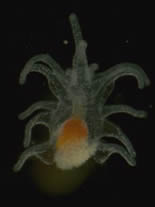
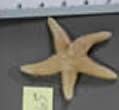  
Brachiolaria (we know it’s a starfish, Who’s ya
Daddy?? [Photos by Alexis Janosik]
but…which one?)
[Microscope Photo by Alex Eaves]
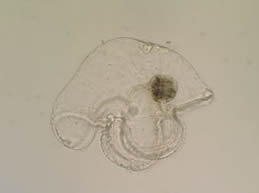
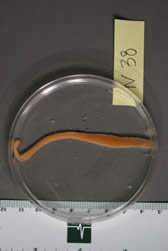
Pilidium larva [Microscope Photo by Alex Eaves] Adult
nemertine or “Ribbon worm”
[Photo
by Alexis Janosik]
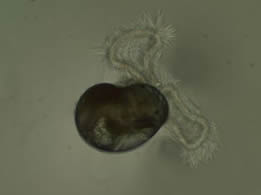
Parent Unknown…
Veliger snail larva [Microscope Photo by Alex
Eaves] …for now[No photo]
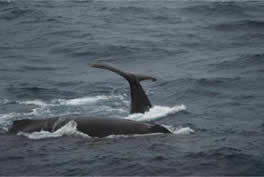
Pair of humpback whales. [Photo by Andy Mahon]
|









